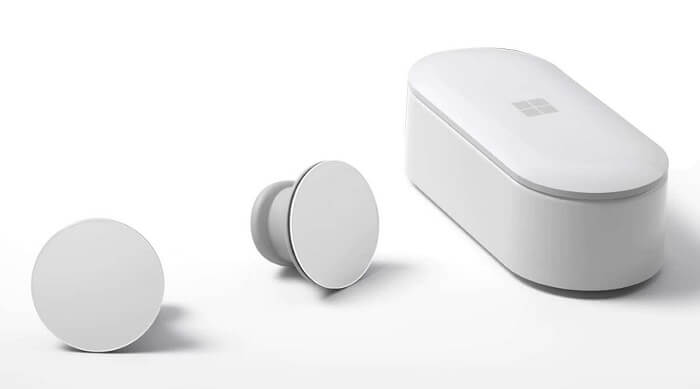Microsoft Surface Earbuds are the company’s first truly wireless earbuds. Since Google has released its Pixel Buds, Samsung its Galaxy Buds. Similarly Apple, Jabra, Sony have revealed their own earbuds. This tight competition forced Microsoft to release its own true wireless earbuds. So here we are with Microsoft Surface Earbuds.
The company claims its Surface Earbuds were developed with an eye toward matchless comfort, a compelling design, rich sound quality, and integration with the Office 365 suite.
Microsoft Surface Earbuds
The Surface Earbuds are another great example of Microsoft’s hardware techs, with the excellent build quality and a design that’s not hesitant to deviate from the rivals. You’ll either adore or reject the appearance of them. It can look like you’re wearing mid-2000s lobe gauges or PopSockets in your ears.
The Surface Earbuds radiate class, even if you’re not disappointed with the style. They’re ranked IPX4 water-resistant, suggesting they can survive splashes from any direction. Microsoft isn’t placing these as fitness earbuds, but if they fit you well, they’ll be relevant to that job.
The Surface Earbuds come in a bright, pill-shaped charging case with the Microsoft logo at the top. There’s a USB-C port around back, a pairing button on the bottom, and that’s the extent of the case. Sadly, it doesn’t have wireless charging capacities. But at under an inch tall and less than three inches wide, it’s very compact and moveable.
Microsoft supports SBC and aptX Bluetooth codecs here — AAC remains out — and we found the connection stability to be rock-solid during our fleeting time outside each day. The Surface Earbuds can stand up to eight hours of constant battery life before requiring a recharge. The case gives two extra refills for a total of 24 hours.
You can check the remaining battery percentage for each earbud, but sadly, Microsoft doesn’t present any method of checking the case’s remaining juice. You’ll know it requires a recharge when the single LED inside turns red, but that’s it.
Regarding the broad, flat surface area of the Surface Earbuds, we presumed their touch-sensitive controls would be an ease. Not really. You can tap twice on either earbud to pause or play music. But Microsoft breaks track controls and volume between the two sides. You swipe forward on the left earbud to skip a song or back to return to the previous one. And over on the right, you can swipe up or down to control volume.
Microsoft’s gesture for bringing up Siri or Google Assistant (just tap and hold on either bud) can sometimes conflict with these controls. And the swipe gestures on the left earbud testified fiddly in our trial. We had to swipe forward or back in a diagonal direction to get the track controls to read. We got the hang of it, but unluckily, you can’t customize the controls; the only option Microsoft allows is disabling them altogether if you’d rather handle everything on-device.
Microsoft uses EQ customization in the Surface Audio app for Windows, Android, and iOS. The app is also what you’ll use to update the earbuds’ firmware. The charging case can only be updated when plugged into a Windows PC.
The Microsoft Surface Earbuds released on May 12 for $199.99 and come in single off-white Glacier color. Microsoft’s buds are comparatively pricey regarding their lack of noise-canceling feature.



















Recent Comments